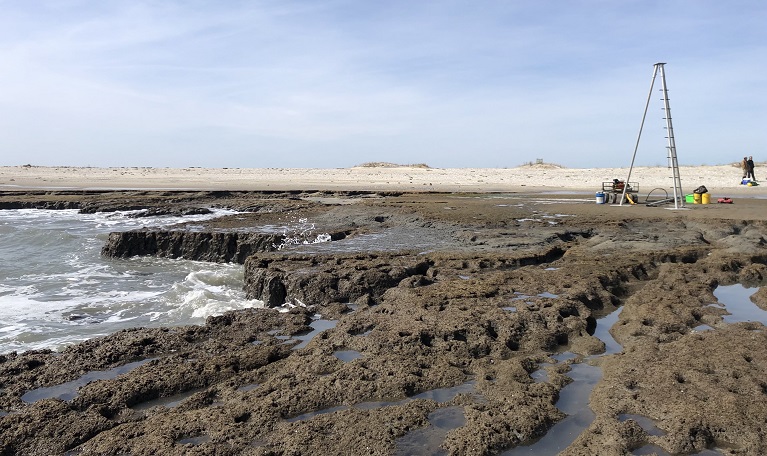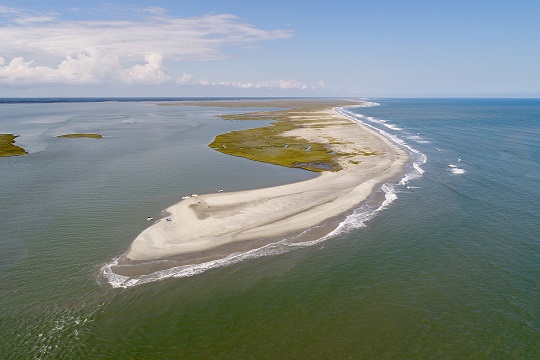Barrier-Marsh Couplings
 |
|
A wealth of recent investigations of barrier behavior have revealed important biophysical couplings between barrier islands, dunes, and backbarrier wetlands. These have found, for example, that seagrasses and saltmarshes fill available accommodation landward of barrier islands, with the latter providing a platform upon which beach and dune systems can migrate and perch. Further, the presence of extensive saltmarsh within backbarrier lagoons reduces backbarrier tidal prism, such that loss of this marsh would lead to enhanced tidal fluxes through inlets, and attendant growth of sandy flood- and ebb-tidal deltas, sequestering sand from adjacent barriers and accelerating island erosion/migration. Our current studies of barrier-marsh couplings builds upon this work, considering implications for carbon cycling and coastal management. |
Current Studies |
Carbon loss due to barrier-island migration: Virginia Barrier Islands Overview: Overview:
Virginia’s barrier islands are migrating rapidly landward as a result of sea-level rise, shallow backbarrier slopes, and a relative lack of sediment availability. In doing so, beach and dune sand is carried to the backbarrier side of the island, overtopping marsh and mudflats. As landward migration continues, these buried peat and mud units are re-exposed on the seaward side of the island. Tide and wave-driven erosion of this re-exposed peat and mud represents an unknown and understudied loss of "blue" carbon from this system. This project aims to estimate carbon losses associated with barrier rollover, while considering the multiple pathways that carbon could take to re-enter the backbarrier environment. A combination of sediment cores, geochemical analyses, and remote sensing allow us to estimate annual carbon loss from the erosion of previously buried peat and mud units. We are interested to discover the roles that migration rates, relative peat and lagoon mud thicknesses, and original backbarrier marsh carbon content play in the size of these potential losses. Collaborator: Matthew Kirwan (VIMS)
|
|
|
Leveraging marsh-barrier couplings to slow barrier-island migration: Cedar Island, VA Overview: Barrier islands and their backbarrier saltmarshes have a reciprocal relationship: aeolian and storm processes transport sediment from the beaches and dunes to create and build marshes along the landward fringe of the island. In turn, these marshes exert a stabilizing influence on the barrier by widening the barrier system and forming a platform onto which the island migrates, consequently slowing landward barrier migration and inhibiting storm breaching. We use Cedar Island as a case study to apply these principles to design a marsh creation project that encompasses input from scientists, engineers, stakeholders, and policymakers to optimize a final plan that balances best-available existing science and models, considers design and financial constraints, identifies stakeholder preferences, and maximizes restoration benefits of habitat provision and shoreline protection. Engineering design, modeling, and permitting of a new 216-acre high (0.46 km2) and low (0.42 km2) marsh platform at the site of a former ephemeral inlet on southern Cedar is ongoing. Overview: Barrier islands and their backbarrier saltmarshes have a reciprocal relationship: aeolian and storm processes transport sediment from the beaches and dunes to create and build marshes along the landward fringe of the island. In turn, these marshes exert a stabilizing influence on the barrier by widening the barrier system and forming a platform onto which the island migrates, consequently slowing landward barrier migration and inhibiting storm breaching. We use Cedar Island as a case study to apply these principles to design a marsh creation project that encompasses input from scientists, engineers, stakeholders, and policymakers to optimize a final plan that balances best-available existing science and models, considers design and financial constraints, identifies stakeholder preferences, and maximizes restoration benefits of habitat provision and shoreline protection. Engineering design, modeling, and permitting of a new 216-acre high (0.46 km2) and low (0.42 km2) marsh platform at the site of a former ephemeral inlet on southern Cedar is ongoing.Collaborators: Keryn Gedan (George Washington University), Michael Fenster (Randolph-Macon College), Emily Hein (VIMS), Jeff Tabar, Tood DeMunda, Daniel Proctor (Stantec), Accomack-Northampton Planning District Commission
|
PublicationsPlease feel free to contact us for pdf copies of any of the following publications. Note: * - Coastal Geology Lab student author Hein, C.J. and Kirwan, M.L., 2024. Marine transgression in modern times, Annual Review of Marine Science. doi: 10.1146/annurev-marine-022123-103802. *Barksdale, M.B., Hein, C.J., Kirwan, M.L., 2023. Shoreface erosion counters blue carbon accumulation in transgressive barrier-island systems, Nature Communications, v. 14, p. 8425. doi: 10.1038/s41467-023-42942-8. Hein, C.J., Fenster, M.S., Gedan, K.B., Tabar, J.R., Hein, E.A. and DeMunda, T., 2021. Leveraging the Interdependencies Between Barrier Islands and Backbarrier Saltmarshes to Enhance Resilience to Sea-Level Rise. Frontiers in Marine Science, 8, p. 721904. |
